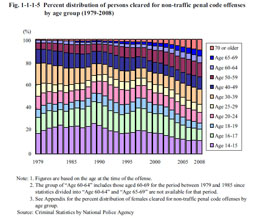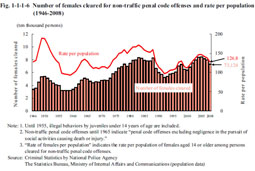| Previous Next Index Image Index Year Selection | |
|
|
2 Persons cleared The number of persons cleared for penal code offenses exceeded one million in 1998, and subsequently reached new post WWII highs every year from 1999 to 2004 (at 1,289,416) before starting to decrease in 2005. In 2008, it was 1,081,955 persons (down 102,381 or 8.6% from the previous year) (See Fig. 1-1-1-1).Table 1-1-1-2 shows the number of persons cleared for penal code offenses by type of offense in 2008 and Fig. 1-1-1-3 [2] shows the percent distribution by type of offense. Examining the number of persons cleared revealed that 68.6% of the total was cleared for negligence in vehicle driving causing death or injury, etc. Fig. 1-1-1-5 shows the percent distribution of persons cleared for non-traffic penal code offenses by age group over the last 30 years. In recent years the aging of society has been progressing. The proportion of those aged 60 or older was 3.1% (11,251 persons) in 1979, but then rose to 20.4% (69,414 persons) in 2008. Those aged 65 or older (elderly) accounted for 14.4% (48,805 persons) (See Section 1, Chapter 4, Part 3). Fig. 1-1-1-5 Percent distribution of persons cleared for non-traffic penal code offenses by age group (1979–2008) Fig. 1-1-1-6 shows the number of females cleared for non-traffic penal code offenses and rate per population since 1946.The number of females cleared for non-traffic penal code offenses reached peaks in 1950 (in the range of 54 thousands), 1964 (in the range of 51 thousands), and 1983 (in the range of 83 thousands). It reached another high after 1983 in the range of 82 thousands in 1988, but then largely decreased for a while after 1989. However, after hitting a minimum in the range of 52 thousands in 1992, it then started to increase again from 1993 and reached a new post WWII high at 84,175 persons in 2005. It started to decrease again from 2006 and was 73,124 persons in 2008 (down 6,446 persons or 8.1% from the previous year). Fig. 1-1-1-6 Number of females cleared for non-traffic penal code offenses and rate per population (1946–2008) Table 1-1-1-7 shows the number of persons cleared for non-traffic penal code offenses by type of offense and by sex in 2008.For males the proportion was the highest for theft at 45.2%, followed by embezzlement (20.9%). For females the proportion for theft dominated at 73.8%, followed by embezzlement (13.3%). The female rate was the highest for infanticide (89.5%). It was also high for shoplifting (42.6%). Table 1-1-1-7 Number of persons cleared for non-traffic penal code offenses by type of offense and sex (2008) |


